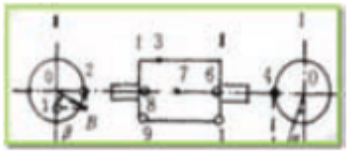Automobile motor rotor unbalance and calibration design
Published:
2019-05-24 14:17
The so-called equilibrium state is a state in which a component of mass m is accompanied by inertial forces in motion. These inertial forces cancel each other in the moving part and do not exert any force on the outside.Adjusting the mass distribution of moving parts in an unbalanced state is called dynamic balance correction.Therefore, rotor balance technology includes two processes of unbalance detection and correction.The balance machine is mainly used for the detection of unbalance, and the correction of unbalance is therefore by means of other auxiliary equipment such as drilling machine, milling machine and spot welder, or by manual gluing.With the development of innovative technology, many dynamic balancing machine manufacturers have already designed the unbalance and correction into an integrated equipment.Apply to manufacturing industry.
For the unbalance detection value, we first need to confirm whether the motor design needs to use static unbalance or force couple unbalance.
1) gravity balancing machine is usually called static balancing machine.It relies on the gravity of the rotor itself to detect the static unbalance.Sometimes also known as single-sided balancing machine, that is, only one plane to detect the unbalance (static unbalance), it is in the rotor rotation to carry out the detection, but still belongs to the static balance machine unbalance.It can be simply understood as the unbalance in one direction of the rotor at rest.(see figure 1 below)
2) centrifugal balancing machine is in the case of rotor rotation, according to the bearing vibration produced by the rotor imbalance, or the vibration force acting on the support to detect the imbalance equipment.Also known as double-sided balancing machine, that is to detect the static imbalance and even imbalance of the dynamic balancing machine.The force couple unbalance can be simply understood as a pair of unbalance in the process of rotor motion

FIG. 1 simple illustration of static unbalance

FIG. 2 simple illustration of unbalance of a couple
Because the motor is in a certain speed to carry out the application, the natural imbalance of mass with the rotation of the rotor will cause many directions of the force couple unbalance, plus their own net balance.Therefore, the mass distribution of moving parts in an unbalanced condition is called dynamic equilibrium correction.Figure (3) firstly selects the simple process design and calculation method of decomposing two irregular points into two planes I and II.Only by understanding the design calculation principle as follows, other complex unbalance is the sum calculation of multiple irregular points superimposed on two planes I and II.

Figure 3 example of calculation principle of dynamic balance
In the rotor of a motor, any imbalance of any kind may be corrected by adding or subtracting the appropriate balance mass in its plane I and plane II.That a quarter of the rotor length, there is a 0.004 kg (as shown in figure 3), the imbalance of particles on the turned 90 degrees is located at 1/2 length, there is a 0.003 kg (figure 7) the imbalance of particle, determine the balance quality on the plane I, II, can be in 3 point imbalance mass point of 180 degrees to the original place, respectively, and 0.003 kg (as shown in figure 9), and 0.001 kg (figure 1) quality of balance.For the unbalanced particle at 7 points, the equilibrium mass of 0.0015kg (as shown in FIG. 8 and 6) can be added on the I and II planes 180 degrees away from it.As the rotor rotates, the centrifugal forces generated by these masses cancel each other out and balance.
The equilibrium masses of 0.003kg and 0.0015kg on plane I are spaced 90 degrees apart and all on the same circumference. Their resultant masses can be obtained by using the parallelogram method as follows:

Similarly, the synthesis mass on plane II is:

If the unbalanced particle is not on the surface of the rotor, it can be converted to the surface calculation according to the principle that the product of the unbalanced mass m and the unbalanced position radius r is equal.Therefore, no matter how large or small the unbalanced mass inside the rotor is, or how complex the distribution position is, each unbalanced mass can always be balanced by two equilibrium masses on plane I and II, and no matter how many equilibrium masses there are on plane I and II, a total equilibrium mass can be synthesized.Therefore, no matter how complex the imbalance inside the rotor is, it is always possible to add 1 mass to the plane I and II respectively to make the rotor balanced.
Aggravation is the addition of a mass in the opposite direction of the known unbalance on the front of the school so that the unbalance caused by this additional mass cancels out the original unbalance.Welding, spraying, gluing, riveting, thread connection and other methods are available for weighting.
The de-weighting is the removal of a mass in the same direction as the unbalance on the front of the known school, so that the unbalance caused by the removed mass is the original unbalance.The method of removing weight can be drilling, grinding, milling, filing and laser drilling.
Related news
2018-12-03
In addition, if you need to buy a balance test machine, please contact us directly.
2018-12-03
Safety operation of the rotor of the motor to be balanced
电机转子装配工的一般操作规程如下: 1、工作前,整理场地,放稳各零、部件,并检查装配使用工具和工作环境是否安全良好。 2、吊放电机机座、底板、定子、转子、轴承等大型部件时必须放好方箱或垫木...
2018-12-03
Rubber roller dynamic balancing machine customer site
Mainly used in the balance correction of high-speed rotating workpieces in various household appliances
2018-12-03
Mainly used in micro-motor rotors, such as automotive motors, household electrical appliances, micro-motors
2018-12-03
[Guangzhou Zhuo Xuanjin] balance machine application range
Dynamic balancing machines are widely used and can be divided into ten categories
2018-12-03
Guangzhou Zhuo Xuanjin various balance machines and their application range
Mainly used in the balance correction of high-speed rotating workpieces in various household appliances, cooling fans, motors, generators, pumps, automobiles, printing, rollers and other industries.

